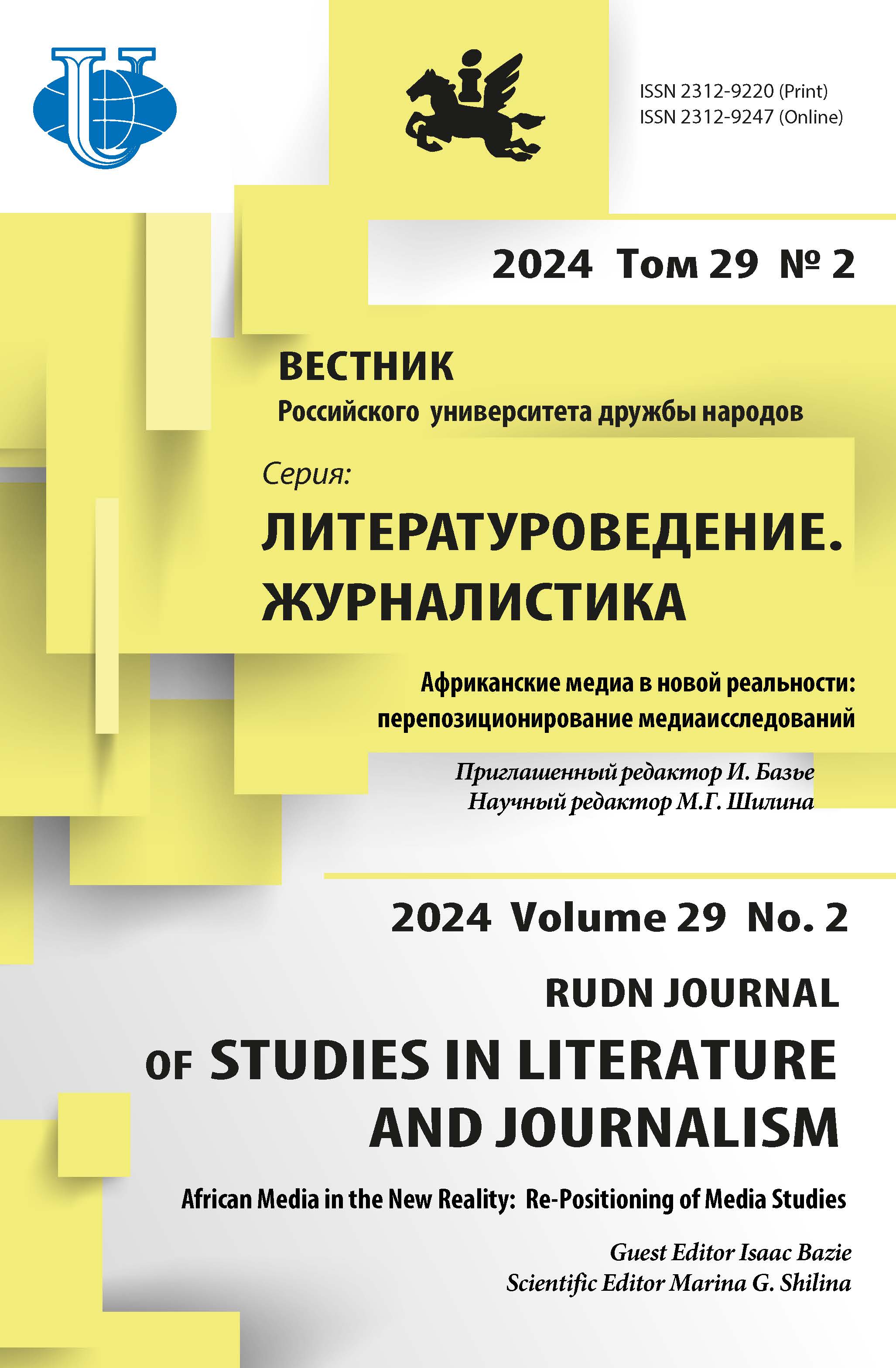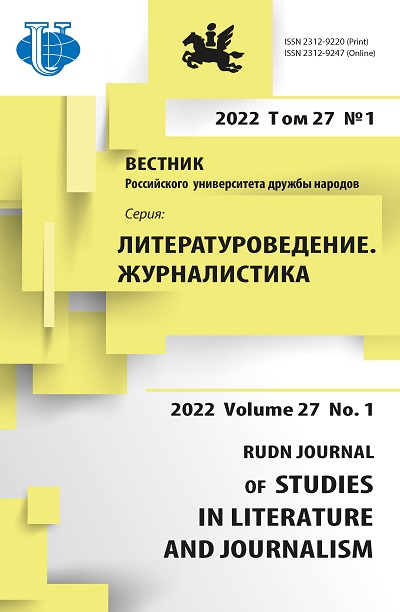Особенности формирования имиджа России на медиаплатформах Сербии
- Авторы: Кунич З.1, Музыкант В.Л.1, Панасенко Н.2
-
Учреждения:
- Российский университет дружбы народов
- Университет Свв. Кирилла и Мефодия в Трнаве
- Выпуск: Том 27, № 1 (2022)
- Страницы: 171-188
- Раздел: Журналистика
- URL: https://journals.rudn.ru/literary-criticism/article/view/30731
- DOI: https://doi.org/10.22363/2312-9220-2022-27-1-171-188
Цитировать
Полный текст
Аннотация
Любая сетевая медиаплатформа, как целостная многофункциональная мультимедийная система, априори обладает совокупностью технологических преимуществ для трансляции общественно значимой информации, при этом медиатекст является ключевым элементом интернет-коммуникаций. В связи с этим медиаплатформу можно рассматривать как одно из наиболее эффективных средств формирования имиджа государства. Авторы проверяют эту гипотезу на эмпирическом материале конкретных медийных платформ Сербии: изучаются медиатексты 2020-2021 годов, посвященные России (ее политике, культуре, истории). Исследовательский вопрос связан с выявлением особенностей формирования и продвижения имиджа России на «цифровой территории» родственного народа. Существует междисциплинарная как теоретическая, так и практическая потребность в изучении медиатекста сетевых платформ как феномена, активно осваивающего мультимедийный формат и различные каналы дистрибуции. Авторы используют лингвистический анализ текстов о России, выявляя стереотипы, присущие жителям Балкан относительно россиян. Было установлено, что на современный имидж Российской Федерации в этом регионе влияют стереотипы, отраженные в текстах, размещенных на сербских медиаплатформах. Особое внимание уделено медиатекстам, отражающим период укрепления международного авторитета России как независимого, последовательно реализующего свою внешнюю политику государства. Проведенное исследование актуально для объективной оценки отношения Балкан к России в контексте вековых межгосударственных связей и традиций славянского мира. Тексты сербских онлайн-медиа демонстрируют понимание авторами ценности общего национально-культурного наследия, лингвокультуры русского и сербского народов. Функционирование современных медиа на Балканском полуострове, выходящих на сербохорватском языке, рассматривается применительно к формированию национального гражданского общества, заинтересованного не только в родном языке, но и в интеграции в славянскую культуру в целом, в развитии эффективного сотрудничества с Россией. Используя технологические возможности медиаплатформ, было установлено, что моделирование имиджа России в сербских медиа в период 2020-2021 гг. является элементом комплексного мультимедийного воздействия на их аудиторию. Результаты проведенного исследования показывают, что репрезентация имиджа России проводилась системно - с учетом ценностей, потребностей и предпочтений южнославянских народов.
Ключевые слова
Об авторах
Звездан Кунич
Российский университет дружбы народов
Email: zvjezdan@mail.ru
ORCID iD: 0000-0003-0582-5450
аспирант кафедры массовых коммуникаций
Российская Федерация, 117198, Москва, ул. Миклухо-Маклая, 10/2Валерий Леонидович Музыкант
Российский университет дружбы народов
Email: vmouzyka@mail.ru
ORCID iD: 0000-0001-9422-351X
доктор социологических наук, профессор кафедры массовых коммуникаций
Российская Федерация, 117198, Москва, ул. Миклухо-Маклая, 10/2Наталия Панасенко
Университет Свв. Кирилла и Мефодия в Трнаве
Автор, ответственный за переписку.
Email: lartispanasenko@gmail.com
ORCID iD: 0000-0003-4377-9088
доктор филологических наук, профессор кафедры языковой коммуникации факультета массмедиальной коммуникации
Словакия, 91701, Трнава, пл. Й. Герду, 2Список литературы
- Быков И.А. Сетевая политическая коммуникация: теория, практика и методы исследования: монография. СПб.: Санкт-Петербургский государственный университет технологии и дизайна, 2013. 200 с.
- Волкова И.И., Ашур Х.Ю.Д. Медиаобраз Иордании в интернет-СМИ Рунета: особенности «неперсонификации» // Вопросы теории и практики журналистики. 2021. Т. 10. № 1. С. 39-50. https://doi.org/10.17150/2308-6203.2021.10(1).39-50
- Гавра Д.П., Савицкая А.С. Структурная модель имиджа государства / региона // Петербургская школа PR и рекламы: от теории к практике. Вып. 4: сб. статей / отв. ред. А.Д. Кривоносов. СПб.: Роза мира, 2006. С. 24-43.
- Грабельников А.А., Нгуен Тхи Зиу. Образ России во вьетнамских сетевых СМИ // Социально-гуманитарные знания. 2017. № 8. С. 114-127.
- Громова Т.Н. Структура медиаобраза России: внешнеполитический аспект // Знак: проблемное поле медиаобразования. 2016. № 4(21). С. 62-67.
- Добросклонская Т.Г. Медиалингвистика: системный подход к изучению языка СМИ: современная английская медиаречь. Москва: Флинта, 2014. 203 c.
- Епископ Афанасий (Евтич). Духовная жизнь сербов // Pravmir. 20.10.2009. URL: https://www.pravmir.ru/duxovnaya-zhizn-serbov/ (дата обращения: 01.04.2021).
- Карпова С.В., Захаренко И.К. Брендинг: учебник и практикум для прикладного бакалавриата. 2-е изд., перераб. и доп. Москва: Юрайт, 2019. 439 с.
- Котлер Ф., Асплунд К., Рейн И., Хайдер Д. Маркетинг мест: привлечение инвестиций, предприятий, жителей и туристов в города, коммуны, регионы и страны Европы / пер. с англ. Санкт-Петербург: Стокгольмская школа экономики в Санкт-Петербурге, 2005. 376 с.
- Красноярова О.В. Новые медиаплатформы: принципы функционирования и классификация // Вопросы теории и практики журналистики. 2016. Т. 5. № 1. С. 45-57.
- Милошевич Б. Современная пресса Боснии и Герцеговины о России // Вестник Череповецкого государственного университета. 2009. № 1. С. 58-62.
- Милошевич З. Русский язык в демократической Сербии. 14 марта 2020. URL: https://regnum.ru/news/society/2884163.html (дата обращения: 23.06.2021).
- Музыкант В.Л., Кунич З., Марьянович Д. Духовный стих в российско-сербской лингвокультурной традиции: стилистика речевых ресурсов // Вестник славянских культур. 2021. Т. 59. С. 248-267. https://doi.org/10.37816/2073-9567-2021-59-248-267
- Най Дж.С. Гибкая власть: как добиться успеха в мировой политике. Новосибирск; Москва: Фонд социопрогностических исследований «Тренды», 2006. 221 с.
- Нистратов А.А., Тарасов Е.Ф. Психологический анализ авто- и гетеростереотипов русских // Человек: Образ и сущность. Гуманитарные аспекты. 2018. № 1-2 (32-33). С. 229-241.
- Почепцов Г.Г. Имиджелогия. М.: СмартБук. 6-е изд., стер. 2009. 575 с.
- Святитель Николай Сербский (Велимирович). За крест честной и свободу золотую. Бог даровал сербам вождя Карагеоргия // Вестник Свято-Пафнутьева Боровского монастыря. 2020. № 30. URL: http://www.pafnuty-abbey.ru/publishing/6333/ (дата обращения: 21.11.2021).
- Хочунская Л.В. Медиаобраз как инструмент ценностной и социальной идентификации // Средства массовой коммуникации в многополярном мире: проблемы и перспективы. М.: Российский университет дружбы народов. 2016. С. 316-320.
- Экосистема медиа: цифровые модификации: монография / ред. С.Л. Уразова. Челябинск: ЮУрГУ, 2021. 246 с.
- Bielik P., Višňovský J. Explanatory journalism - a new way how to communicate in digital era // Media literacy and academic research. 2021. Vol. 4. № 1. P. 24-37.
- Greguš Ľ., Kačincová Predmerská A. The foreign news and media image of the European Union in current television news production // Communication today. Vol. 11. 2020. № 2. P. 84-102.
- Mináriková J., Blahút D. & Višňovský J. Hi-tech and eye-catching alike: information in the multiplatform era // European journal of media, art & photography. 2020. Vol. 8. № 2. P. 118-126.
- Panasenko N., Greguš Ľ., & Zabuzhanska I. Conflict, confrontation, and war reflected in mass media: semantic wars, their victors and victims. // Lege artis. Language yesterday, today, tomorrow. 2018. Vol. 3. № 2. P. 132-163. https://doi.org/10.2478/lart-2018-0017
- Panasenko N., Kryachkov D. Some text categories in media communication // Text - Sentence - Word. Studies in English Linguistics. Vol. IV. / A. Uberman & A. Trinder (Eds.). Rzeszów: Wydawnictwo Uniwersytetu Rzeszowskiego, 2020. P. 85-97.
- Panasenko N., Krajčovič P. & Stashko H. Hard news revisited: a case study of various approaches to the incident at the primary school reflected in the media // Communication today. 2021. Vol. 12, № 1. P. 112-128.
- Višňovský J., Radošinská J. Online journalism: current trends and challenges // The evolution of media communication / B.P. Acuña (Ed.). Rijeka: InTech, 2017. P. 3-22.
















